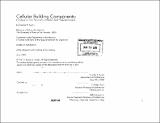Cellular building components : investigation into parametric modeling and production logics
Author(s)
Austin, Charles B., M. Arch. Massachusetts Institute of Technology
DownloadFull printable version (18.30Mb)
Other Contributors
Massachusetts Institute of Technology. Dept. of Architecture.
Advisor
J. Meejin Yoon.
Terms of use
Metadata
Show full item recordAbstract
Recent advances in digital fabrication technologies have sparked a renewed interest in topology and biological form. The ability to design and prototype structural forms inspired by nature has challenged architects preconceived notions of space and form. With the assistance of parametric modeling and rapid prototyping we now not only have the ability to physically generate complex forms, but also the ability to create a seemingly infinite number of formal variations. As a result, this has caused architects to push toward new spatial concepts. Among these new spatial concepts are those that seek to create entire building systems out of a single material solution. Inspiration for such systems can be found by studying organic cellular structures. Unlike the component based design processes of most architects, in which multiple problems are solved through multiple material solutions, natural systems tend to create solutions that solve multiple problems through one material solution. This thesis is interested in answering the question, "Is it possible to create a building system (both structure and enclosure) out of a single adaptable building unit?" Furthermore, can the building unit also be capable of transforming from being either permeable to impermeable? If so, how might this challenge our existing notions of boundaries?
Description
Thesis (M. Arch.)--Massachusetts Institute of Technology, Dept. of Architecture, 2005. MIT Institute Archives copy: P. 85-86 bound in reverse order. Includes bibliographical references (p. 86).
Date issued
2005Department
Massachusetts Institute of Technology. Department of ArchitecturePublisher
Massachusetts Institute of Technology
Keywords
Architecture.